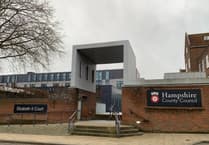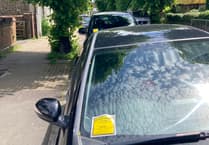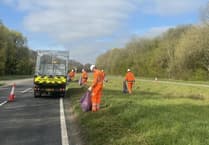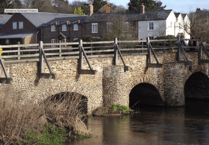CHILDREN returning to St Lawrence Primary School this week may have been forgiven for thinking they had stepped into a scene from Channel 4's Time Team. Southampton-based firm Gifford Archaeology, appointed by Hampshire County Council, is in the throes of an investigative dig in part of the playground which will eventually house the new school hall. Initial archaeological trenches indicated that finds would be likely, and the experts have since unearthed a number of historic graves. Early speculation is that the remains date from between the 16th and 17th centuries, but it is possible that some could date from as far back as Roman times. The archaeologists estimate that there are around 50 burials on the site. It is an exciting time for the school which is one of the few of its size in Hampshire which does not have a hall of its own. Built within the walls of St Lawrence Churchyard, a condition of planning was to have the site archaeologically explored. The school lies adjacent to the graveyard of St Lawrence's Church, the earliest parts of which date back to the 12th Century. A significant battle took place on the site during the English Civil War in December 1643, and it is possible that this excavation could provide more information about this event. According to the archaeologists on site, while the test trench threw up evidence, as was expected, from the Civil War, the actual hall site was telling a different story. Site supervisor Dan Sykes said a Roman hairpin had been discovered along what appeared to be the cemetery boundary and digging had also thrown up neolithic flint flakes. But there has been nothing more significant, other than the bones themselves. The archaeology team has already unearthed graves at different levels, with the earlier shallow burials on top of later deeper ones. The graves have revealed the remains of adults and juveniles. According to a statement from Hampshire County Council, those remains which cannot be left in situ will be excavated by the archaeologists who are working for Giffords. Bone experts will then seek to identify the age and gender of the deceased, how long ago they died, and in some cases, cause of death. The remains will be examined before being returned to the church for burial, in line with best practice guidance from English Heritage and the Church of England. Vicar of St Lawrence Church, the Revd Peter Doores, is not surprised by the find. "It is what you would expect in a former churchyard," he said. The school site is, however, no longer consecrated ground and once excavated it will be built on. "These graves are quite old - we are not talking about people who are likely to have living relatives and when the remains are returned they will be reinterred. I am not sure where as yet, but we will do something appropriate," he said. According to Hampshire County Council leader Ken Thornber, the find is not expected to delay construction of the school hall. "It is not thought at this stage that the extended archaeological investigation will delay the start of construction work which is still scheduled to begin at the end of September. "Although we anticipate the archaeologists to still be on site when pupils return from the summer holidays, their work will not disrupt the day-to-day running of the school." Gerry Wait, technical director at Gifford, said: "It is not unusual for a location adjacent to an existing church graveyard to contain remains, as the boundaries of the burial area would have changed over the centuries. This investigation has revealed the northern extent of the graveyard and what could prove to be an exciting insight into the area's history and its inhabitants. "Interestingly, the northern part of a cemetery was usually left for the burial of 'undesirables', for example unbaptised individuals, thieves and vagrants. Further analysis will tell us exactly how many are buried on the site, and how long ago they lived." The archaeologists have already been on the site for four weeks and are expecting to remain for a further three. While the burial site is currently closed off to enable the archaeologists to get on with their work, it is expected to be opened up to visitors for viewing once the dig has been completed. In the meantime, Gifford is preparing information boards which will be put up around the site to explain the excavation work and to keep people informed of the archaeologists' progress.



